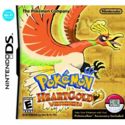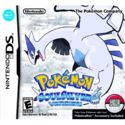Pokémon: HeartGold and SoulSilver Versions
 
| |
| Pokémon: HeartGold/SoulSilver Versions | |
| Developer | Game Freak |
| Publisher | Nintendo |
| System | Nintendo DS |
| Release Date | JP September 12, 2009 KO February 4, 2010 US March 14, 2010 EU March 26, 2010 |
Pokémon: HeartGold and SoulSilver Versions are fourth generation remakes of the second generation Gold and Silver Versions for the Nintendo DS. They are modified with improved graphics and features akin to those from the fourth generation Pokémon: Diamond, Pearl and Pokémon: Platinum Version, as well as new features and storyline alterations.
Version Differences[edit]
The game features a new graphical style, with some areas being redesigned and new ones being added, in addition to all gyms being overhauled. The game also has gender selection feature, with the character of the unselected gender becoming a secondary rival character (similar to the relationship between Brendan and May or Lucas and Dawn in previous games). The game also oddly enough borrows a feature from Pokémon: Yellow Version by allowing one Pokémon to follow the trainer around outside of its Pokéball, although unlike Yellow any of the 493 Pokémon can be selected for this. The game also has a new minigame area known as the Pokéathlon as well as including the fourth generation's Battle Frontier.
The game also includes alterations to the storyline. Eusine's sidequest with Suicune from Crystal Version is included, and the Kimono Girls have an expanded storyline role, now playing a pivotal role in helping the player to reach the first of the game's two legendary birds (Ho-Oh and Lugia). Additionally, the Team Rocket storyline replaces the nameless Rocket Executives with a new set of characters named Archer, Ariana, Petrel and Proton. Other new sidequests include the option of finding gym leaders' phone numbers and challenging them to rematches after finding access to Kanto. The games also have a fair amount of cameo appearances by characters from the third and fourth generation games, and eventually it is possible to catch nearly all Pokémon from other regions. This includes legendary Pokémon such as Kyogre, Groudon and Rayquaza. Other special events unlocked by Nintendo events include appearances by characters like Cynthia and Giovanni.
Connectivity[edit]
HeartGold and SoulSilver are capable of connecting with Diamond, Pearl and Platinum to trade and battle Pokémon. The games also have their own Pal Park, through which Pokémon from one of the third generation GBA games inserted in the GBA slot can be transferred permanently to these games.
The game is also packaged with the PokéWalker, a Pokéball-shaped pedometer. A Pokémon can be transferred into the PokéWalker, and it will gain experience and happiness as the player walks. The "watts" that accumulate with each step act as currency to unlock new courses as well as to find hidden items and encounter various Pokémon, many of which are not found in the actual games.
Continuity Notes[edit]
- Most of the continuity references from Gold/Silver/Crystal are retained, and it is maintained that the game is set three years after Red/Blue/Yellow. It is also mentioned that Cinnabar Island's volcano erupted a year ago, meaning it occurred two years after the first generation games.
- These games also make a retcon as to the number of Pokémon that the public is aware of. The original second generation games had people only knowing of the 251 Pokémon that were around at the time of those games, but this time it is presented as common knowledge that there are nearly 500 kinds of Pokémon.
- References to third generation events: Steven Stone appears in Kanto pursuing Latias or Latios and is referred to as Hoenn League Champion, confirming that this is still set prior to the third generation games. Bill also alludes to his work with Lanette.
- References to fourth generation events: Maylene and Crasher Wake make cameo appearances in the game, as do the Battle Frontier (with Palmer's dialogue having been revised to avoid continuity errors from his dialogue originally specifically referring to the fourth generation player character). Jasmine also mentions her intentions of traveling to Sinnoh to compete in Super Contests, which she eventually does in Diamond/Pearl/Platinum. Cynthia appears at the Sinjoh Ruins during the special Arceus event and is referred to as Sinnoh's champion. This and Jasmine's foreshadowing also confirm that the fourth generation games still take place after these games.
- One of the special Nintendo events features an appearance by Giovanni and shows why he never responded to Team Rocket's radio calls, a mystery that had been left unanswered in the original second generation games. This event also reveals Silver as Giovanni's son, which had been implied in FireRed and LeafGreen.
Legacy[edit]
Sequels[edit]
The next Pokémon games to be released were the fifth generation Pokémon: Black and White Versions. HeartGold/SoulSilver in specific later received a technical follow-up in the form of the remakes of the third generation games for the Nintendo 3DS as Pokémon: Omega Ruby and Alpha Sapphire Versions in 2014.
| Mainstream titles of the Pokémon Series |
|---|
| I: Red/Green/Blue (Yellow - FireRed/LeafGreen - Let's Go, Eevee/Pikachu!) - II: Gold/Silver (Crystal - HeartGold/SoulSilver) III: Ruby/Sapphire (Emerald - Omega Ruby/Alpha Sapphire) - IV: Diamond/Pearl (Platinum - Brilliant Diamond/Shining Pearl) - V: Black/White (2) VI: X/Y - VII: Sun/Moon (Ultra) - VIII: Sword/Shield - Pokémon Legends: Arceus - IX: Scarlet/Violet |